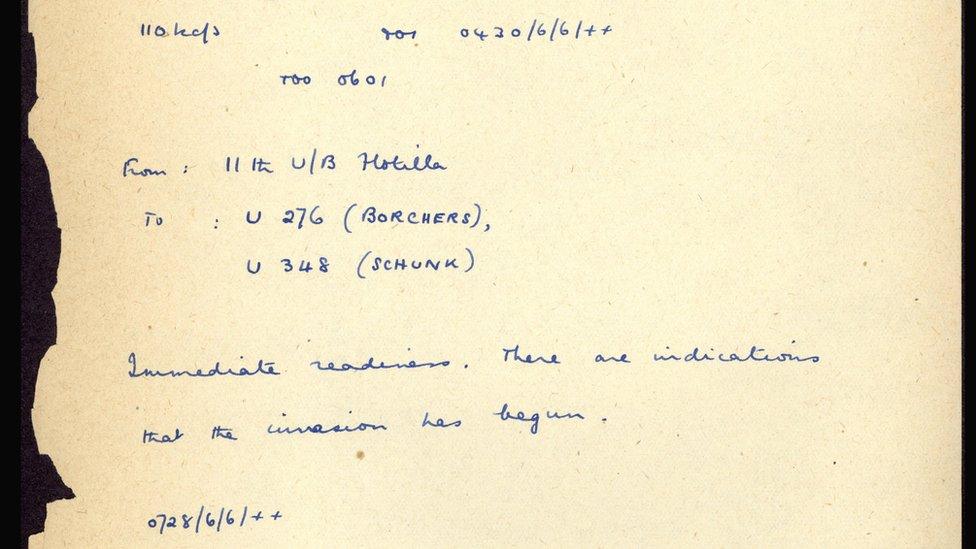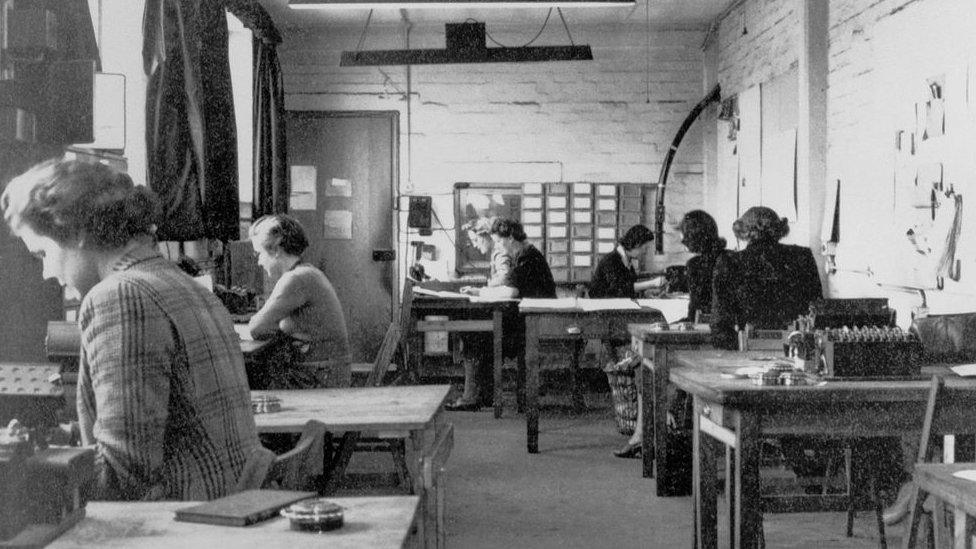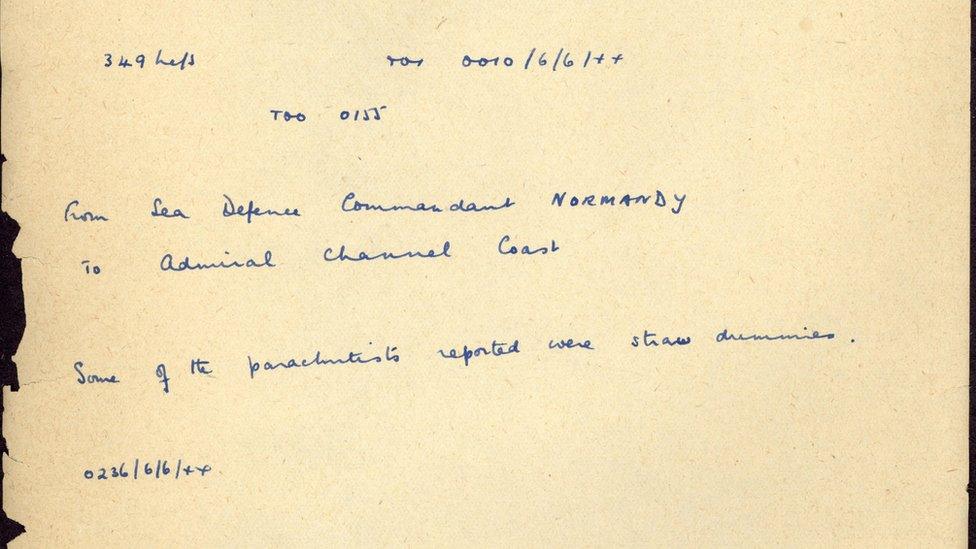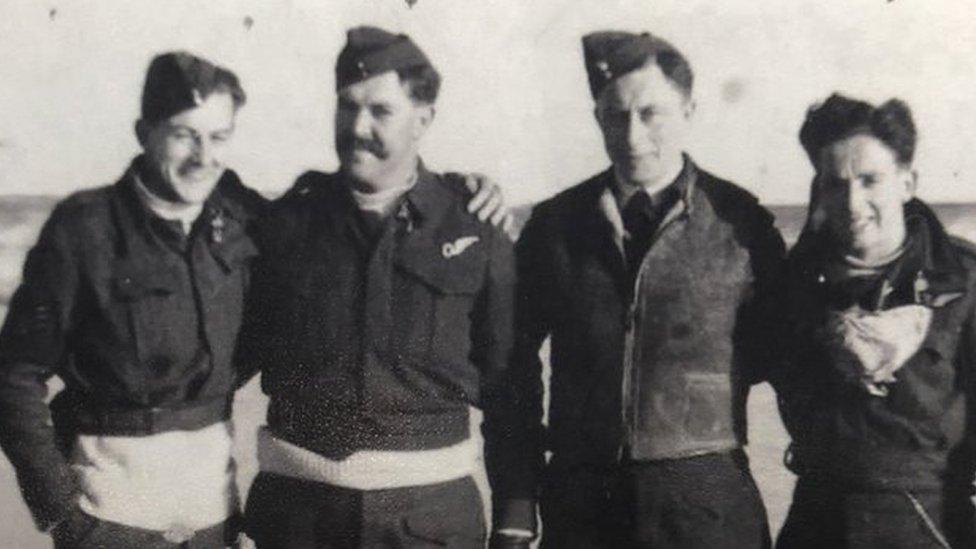Bletchley Park reveals decrypted Nazi D-Day messages
- Published

A rare surviving handwritten transcript of a German Enigma message reads: "Immediate readiness. There are indications that the invasion has begun."
Messages sent by the Nazis on D-Day are being relayed in real-time on the 75th anniversary of the landings.
Code breakers at Bletchley Park decrypted the messages and passed them to Allied commanders on 6 June 1944.
The museum's Twitter account, external is posting the communications, which show how the Germans came to realise the Allies were landing in Normandy and not Calais.
Bletchley Park historian David Kenyon said the messages gave a "powerful insight" into the Germans' response.
"Over the course of the day, you can see the German commanders try to understand the scale of the invasion, sifting through fact and subterfuge to find out what was really going on," he said.

Codebreakers worked at Bletchley Park in Buckinghamshire to intercept and decrypt Nazi messages in World War Two
The account will be live-tweeting between 00:58 and 23:38.
During these hours on 6 June 1944, Bletchley Park took the risk of having an interception station on site to speed up the code-breaking process.
Allow X content?
This article contains content provided by X. We ask for your permission before anything is loaded, as they may be using cookies and other technologies. You may want to read X’s cookie policy, external and privacy policy, external before accepting. To view this content choose ‘accept and continue’.

It was the only time during the war that enemy signals were intercepted at Bletchley Park as code breakers normally relied on secret listening posts, known as "Y" stations.
On D-Day, listeners on-site were monitoring German Enigma traffic to see what was being said about the invasion and if there were any threats to the Allied fleet at sea.
The German naval messages were being intercepted, decrypted, translated and sent to Allied Commanders within two-and-a-half hours.
As the hours went on, the Germans began to anticipate the Allied forces taking action in numerous locations.
Allow X content?
This article contains content provided by X. We ask for your permission before anything is loaded, as they may be using cookies and other technologies. You may want to read X’s cookie policy, external and privacy policy, external before accepting. To view this content choose ‘accept and continue’.

One intercepted message referenced the deception which was used by the Allies in the build-up to the landings.

Allied commanders organised "leaks" of misinformation to convince the Germans the invasion was going to be near Calais, not Normandy.
They also released 500 dummy paratroopers over France to give the impression of larger landings.
Allow X content?
This article contains content provided by X. We ask for your permission before anything is loaded, as they may be using cookies and other technologies. You may want to read X’s cookie policy, external and privacy policy, external before accepting. To view this content choose ‘accept and continue’.


Cracking the codes
The German army and navy used Enigma machines to scramble messages and make them much harder to decipher
In an effort to crack the complex messages, a code-breaking computer was created - called the Bombe
The Bombe was designed to discover which settings the German Enigma operators used to encrypt their messages
It enabled code breakers at Bletchley Park to decrypt thousands of messages each day

Peronel Craddock, head of collections at Bletchley Park said: "We hope that this 'Twitter Takeover' will give people a powerful sense of what it was like to be at Bletchley Park on D-Day, learning about the fate of the Normandy invasion through the reactions of the Germans.
"The 7,000 strong workforce at Bletchley Park were decrypting almost 5,000 Enigma messages a day, so these 182 messages represent just a fraction of their output on 6 June."
- Published5 June 2019

- Published5 June 2019

- Published5 June 2019
